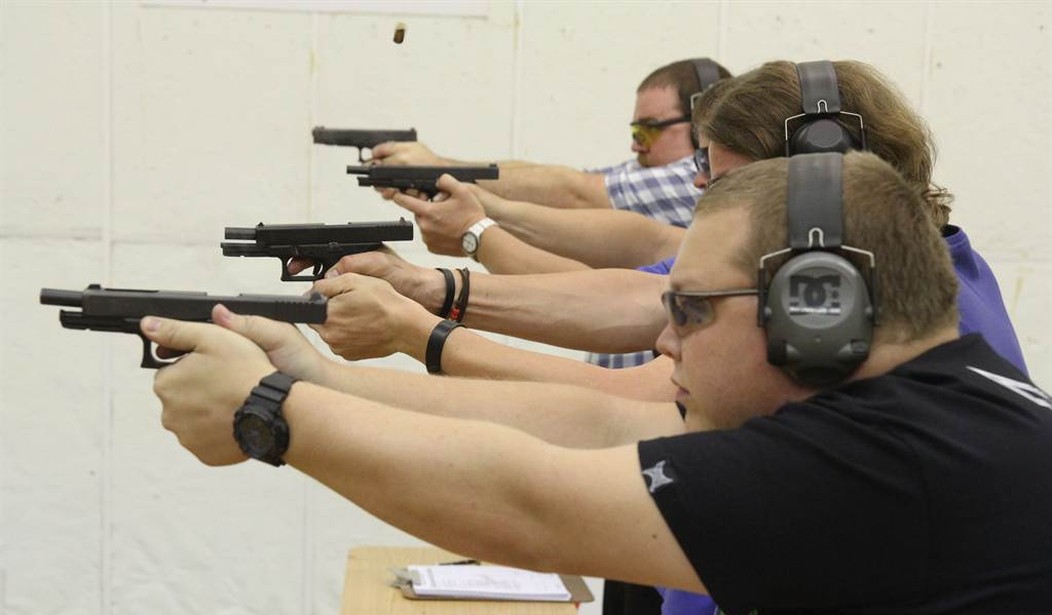Assailants rarely stand still and announce themselves as a “threat.” In the September issue of Townhall Magazine, where this article originally appeared, BearingArms.com's Bob Owens asks if your firearms training is realistic.
I’ve been to a number of different self-defense courses in the past 20 years, almost all of them focused on drawing and shooting at a stationary paper target at a known distance on a static firing line after the lead instructor has shouted “threat!”
I’m now supremely confident that if I am ever attacked by a stationary paper target, I will survive.
Unfortunately, criminals rarely shout “threat!” as they attack, they don’t conveniently stand stock-still, and they’re incredibly uncooperative with their would-be victims. The sad fact of the matter is that even most “advanced” self-defense classes offered by reputable organizations and shooting schools only prepare us to deal with caricatures of threats, and generally in manners that won’t succeed in a real conflict.
For example, you might be told that once you are given the fire command, you are to fire two shots into the center of target “A” and then run to cover, perform a reload while hiding behind cover, and then engage with target “B” as you emerge from cover on the opposite side. You knew what to expect the entire time, because the scenario was explained completely beforehand.
An advanced class might feature a more complex drill involving reactive targets (targets that move after being struck just once, or after a prescribed number of times) and “no shoot” non-threatening targets representing normal people going about their daily lives. Instead of engaging a specific number of targets in a specific order with a specific number of shots, the shooter is going to have to read the situation at each point of the process and think their way through the scenario as they encounter possible threats.
Recommended
Such a class introduces complexity and is more realistic but the course of fire, once set, is set. The reactive target can’t decide to become a non-threat, and the “no shoot” can’t drop a bouquet of flowers as it draws a knife and charges you, and you are generally not allowed the best defensive option, which is creating space between the assailant and yourself, running if you can.
To get the semblance of a real threat, humans need to attack other humans.
It is because of this need for more realistic force-on-force training that the U.S. military introduced the Multiple Integrated Laser Engagement System in 1980, and later added man-marker rounds that allowed servicemen to use their real weapons with conversion kits that would only fire paintball-like or wax-based marker rounds.
In more recent years, many companies have added force-on-force training courses for civilians that use commercial, off-the-shelf airsoft firearms that mimic the action of modern firearms, but which fire lightweight 6-millimeter plastic BBs at a reduced velocity.
I was recently able to witness force-on-force training using realistic airsoft pistols. Trace Armory Group incorporated force-on-force scenario training in their NRA defensive pistol class. After a morning of shooting real handguns at paper targets, students were directed to the Camp Butner MOUT (Military Operations on Urban Terrain) range for role-playing exercises that happened in, around, and among the range’s buildings. The defending student was armed with an airsoft pistol in an inside-the-waistband holster, and would be expected to “act appropriately” to the appearance of an unexpected person or persons.
In some scenarios the opposing role-player was nothing more than a curious person engaging the defender in conversation. In others, they were intent on an all-out attack with a handgun, knife, or blunt object. In other scenarios, the assailant was informed to react to the defender, and only to attack if the defender gave them an opportunity, letting the opposing player get close enough to use a knife or bat.
While not perfectly mimicking real life, the course quickly informed every student that shooting at paper targets from a static position is poor preparation for a real life defensive scenario.
In the 70-plus scenarios I saw acted out, the defender had the opportunity to establish a classic two-handed firing grip just once; the rest of the engagement was typically one-handed hip shooting or point shooting with only the rare use of sights.
In many scenarios, the defender was using their support side hand to ward off attacks that often didn’t develop until opposing players were an arm’s length away. Static, stay-in-your-lane shooting might make liability insurance for shooting ranges more affordable, but is it preparing you to deal with real life threats the way that force-on-force training might? •
























Join the conversation as a VIP Member